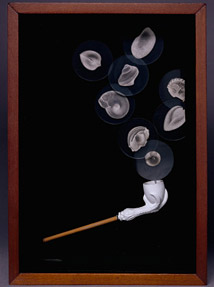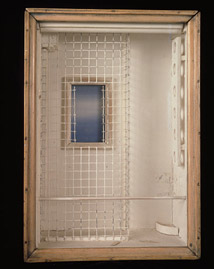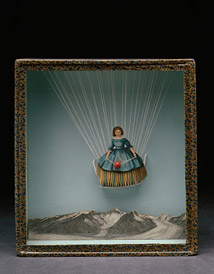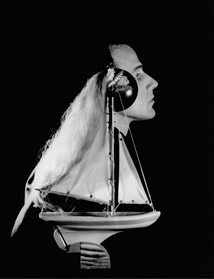Joseph Cornell: Wanderlust
This article first appeared in The TLS, 19 August 2015
“Incredibly beautiful brace of dreams about being in London”, wrote Joseph Cornell in his diary of 1957. Although in real life he barely left New York his knowledge of London was almost as detailed as his familiarity with the similarly unvisited streets of Vienna or Paris. Maybe he would not have been able to place the Whitechapel Gallery where Nicholas Serota arranged the first of a brace of major London exhibitions in 1981, but he would certainly have pinpointed the Royal Academy which now houses the second.
Here at Burlington House he would as an eager polymath have felt at home among the learned societies its courtyard contains, tempted equally by the headquarters of antiquaries, geologists, Linneans and astronomers whose matters feature so richly in his work. In the Academy itself he might have gravitated towards its fine library the treasures of which are only a step away from where his art is now displayed.
These and many other less academic interests led to and emerged from a passion for collecting. In the hours off from various humdrum jobs he haunted the thrift shops and the dealers in bric a brac of Lower Manhattan. ‘Only collect’ was the mantra of his early twenties. There seems to have been no identifiable moment when the Forsterian imperative ‘Only connect’ beckoned him to evolve from hoarding material to making that material serve a larger project and, eventually, to becoming (to use a word he would only reluctantly apply to himself) an artist.
Without any formal study (but with much wide and unfettered reading) this Autolycus snapped up an education out of particularities, a label here, a star chart there, a child’s toy or a sweet wrapper, things which others might consider trifles. When Autolycus thus meets autodidact in the person of a fantasy flaneur learning has more breadth, scope and surprise than academic scholarship would afford. More importantly there is an equality of value such as a pre-war English child might have randomly accepted from the informative backs of cigarette cards, thinking that who reigned in Shakespeare’s day, which steam train was the world’s fastest or who captained the Essex cricket team must be facts of identical status. The child in Joseph Cornell never lost that sense of universal worth and managed to bring it intact into his maturity.
His avoidance of structured training extended into his eventual career. He never attended any course in artistic practise or attempted to develop those normal accomplishments of drawing, painting or sculpting regarded as the standard armoury of the artist. This was not only the result of the relative privations of his domestic circumstances. He had a widowed mother to care after as well as a brother disabled by cerebral palsy, whose brave spirit he never ceased to admire. He accepted limitations in his life and work, somehow making them serve his purpose, strengthened as he was by his devout belief in the tenets of Christian Science with its promise of personal epiphanies.
In common with many dreaming young artists his first studio was the kitchen table. For him this was usable when the family was asleep. It was only in 1941 at the age of thirty eight, having abandoned regular employment, that he converted the basement of the small house on the cherishably named Utopia Parkway into a proper, though still cramped, workspace. Its shelves were soon piled high with his tottering cartons and packages labelled ‘shells, watchparts, balls, birds, tinted glass, Dürer, maps, corks’ etc, like Touchstone’s ‘great reckoning in a little room’.
This space served him for the rest of his life which gives a nice irony to the subtitle of the exhibition ‘Wanderlust’, a word that will have an even fitter resonance when the show goes on to Vienna where ‘lust’ has the added flavour of ‘delight’. The contents of the shelves indicate the scope of his sources as well as the restriction of their character since the virtual rule of his output was only to use pre existing material. Each of the items and scraps has, in addition to its image, a stylistic history which locates it in time, a dimension he explored as thoughtfully as geographic and astral space. By technique and juxtaposition (a snippet from a chromolithograph joining part of a carte de visite to a nineteenth century reproduction from a sixteenth century painting combined with a contemporary street map) this playing with time in his constructions both gave and freed them from modernity.
Much of the material was destined to inhabit the glass covered boxes for which he is best known. The boxes were themselves mostly ready-made items from his usual junk shop sources either used straightforwardly or ingeniously treated or adapted. He referred to the resulting artefacts as ‘objects’ and they form a continuous life project. This huge series was divided into singular examples or thematic groups under titles such as ‘Soap Bubbles’, ‘Habitat’, ‘Aviary’ or ‘Penny Arcade’. The last mentioned gives a probably unintentional echo of another extended project, Walter Benjamin’s beautiful concept likewise linking time and space within a partly imagined Paris. Lacking such a strict discipline of format, Benjamin’s Arcades Project threatened to expand into incoherence. Cornell, however, found exactly the right vehicle, an equivalent in scale to chamber music and reminiscent of Scarlatti with his series of 555 one movement keyboard sonatas; these, like Cornell’s boxes never dip too far in quality and include a good few masterpieces.
Most of the boxes provide a space more like a toy theatre than a dolls’ house with the front doorway of the container acting as a proscenium to a narrow stage. Though some contain solid objects the interiors are three dimensional only in the way that stereoscopic photographs present the world as layers like the flats of a theatre stage. Thus they can contain parrots or dancing figures as one dimensional cut outs tricked into life.
Here and there, even in a well chosen exhibition such as this, one or two of the boxes seem too incommunicably personal to register. Others, though superficially as inexplicable, haunt as Cornell is haunted. The only piece of up to date technology that he regularly employed was the photostat which in varying repetitions speaks of distance and loneliness. Perhaps Cornell was lucky in not having the bewildering wizardry of current photographic treatments at his disposal.
Many of the most moving objects are abstract with no illustrative reference such as Toward the Blue Peninsula for Emily Dickinson of 1953, dedicated to an artist similarly restricted in circumstance and similarly liberated in imagination. The featureless view from its window recalls, perhaps intentionally, another image of confinement, Oscar Wilde’s ‘that little tent of blue which prisoners call the sky’.
The exhibition designer Carmody Groarke has cunningly transformed the Sackler Galleries themselves into a nest of boxes which allow or even urge one to view the objects close up. In the middle of the sequence of rooms one finds oneself in a miniature cinema to view one of Cornell’s short film works. He was an avid collector of film fragments of old comic or documentary stock. As in so many fields he became a recognised expert in the early cinema and made what he called ‘goofy newsreels’, simultaneously dark and daft, by treating and collaging disparate movie episodes. Even in his more ambitious films he stuck to his old guidelines by not originating the material he used. He did not want to wield the camera or even be on site to direct the shooting. He found a willing collaborator in the Swiss experimental filmmaker Rudy Burkhardt and would indicate with notes the kind of shots and angles he wanted. In 1955 he commissioned the young avant garde film artist Stan Brackhage to work on a film of the elevated railway he loved travelling. The result, Wonder Ring, was too admirably artistic for Cornell’s taste and he produced an alternative version Gnir Rednow from the footage and out-takes. Cornell knew and often visited Francois Doublier a surviving cameraman from the team of the Lumière brothers. To have been a link between the almost prehistoric Lumières and the then little known cinematic firebrand Stan Brackhage shows the generous compass of Cornell in his fields of enquiry and creativity.
It was at a showing of Cornell’s films at the Julien Levy gallery in 1936 that Salvador Dali notoriously accused Cornell of raiding and stealing from his (Dali’s) unconscious mind. One can gleefully imagine what kind of courtroom dialogue would have ensued had the matter come to law. The link with surrealism always upset Cornell who had a dislike of isms in general. He wrote to Alfred H. Barr in that same year disowning the label of surrealist, asserting that ‘healthier possibilities than have been developed’ could have come from that movement.
Although his filmwork has attracted some attention in recent years his writing has not been fully enough explored since Mary Ann Caws’ study and selection appeared in 1993. Cornell was a copious and compulsive diarist who registered the minutiae of his everyday existence with weather, moods and small routines (brushing his teeth, waving good bye to his brother) meticulously noted. While never ignoring the quotidian grind his prose is regularly vivified by invention, as with the verbal collage ‘brace of dreams’. From scribbled notes he would type up many of his days in dense paragraphs. His virtuosity at the typewriter can be seen in the towering concrete poem The Crystal Cage, which embodies an inevitably incomplete inventory of his favourite topics.
Cornell used to be spoken of as an unworldly recluse, obsessive, unsociable, suspiciously celibate, a monkish figure who hardly engaged with his contemporaries or their concerns. As the history of 20th century art is pieced together almost the opposite picture emerges. Innumerable connections and friendships with fellow artists, cineasts, collectors and performers have come to light. In his dealings with galleries he was practical, as he was astute in the management of his career. If he was not known to a wide public there was scarcely an artist of note whom he did not have some association with, assisting Duchamp with his valises for example, or politely declining Matta’s offer of drawing lessons or engaging in long metaphysical conversation with de Kooning. A hint of the warm respect he gained appears in a note from the not normally expansive Mark Rothko who in 1957 wrote, ‘I think of you and the uncanny magic of the things you make’.
In his later years Utopia Parkway became a place of pilgrimage with a rising generation, including the pop artists who owed him so much such as Andy Warhol, Robert Indiana and James Rosenquist coming to pay their respects. No one could truly be called obscure who in his lifetime both had a solo exhibition at the Metropolitan Museum of Art and was visited by John Lennon and Yoko Ono.
His love of music and especially of ballet led to welcome meetings and correspondence, Tamara Toumanova and Tilly Losch becoming special friends. Being Cornell he also felt drawn to the ghosts of earlier theatrical figures, admiring singers (Malibran and Pasta) whom he never heard sing and dancers like Cerrito whom he never saw dance. The dead were as often the dedicatees of his objects as the living.
As the exhibition makes clear his visual strategies like those of almost every artist begin derivatively. Max Ernst’s collages supply a starting point although he soon forsakes their cruelty and violence. As his own imagery comes into focus he can play out a longer and more gentle psychodrama with his own modes of reference whose key would read more like Swedenborg’s Dictionary of Correspondences than any conventional symbolic code. But yet the mood is clear and one becomes attuned to the sensibility rather than the system.
The catalogue is exemplary with its sensitive introductory appraisals by the curators, Jasper Sharp and Sarah Lea and a more than serviceable chronology by Ben Street. It is that sort of exhibition guide which, sampled on one’s return home, makes one want to go back to the show immediately, armed with its ideas and insights. Especially welcome are the notes, mostly by Sarah Lea. Refreshingly free of artspeak they appear exactly where one would want them, on the page facing the illustration of each exhibit.
Joseph Cornell was invariably described as gaunt and pale. The camera, however, in filmmakers’ parlance, loved his face, as can be seen in the poetic photographs by Duane Michals and the wonderful 1933 image of him merged with a toy boat, by Lee Miller. His art, which used to be spoken of as ‘marginal’ is now thought of as canonical. Better to leave the matter in the hands of Derrida who maintained that in art especially ‘the margins are at the centre’. It is a pity that we feel obliged to use rankings like those stars that critics now give to cultural events. Words like ‘great’ or ‘minor’ are little use with a figure like Cornell who is partly both. What is certain is that in two and a half dimensions he is hard to beat.




